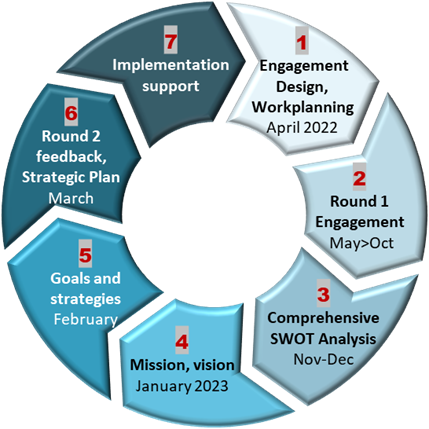Health Promotion and Chronic Disease Division
Related Topics
Health Promotion and Chronic Disease (HPCD) Strategic Planning
On this page
Background
Implementation
Engagement
Key stakeholders
More information
Vision
In Minnesota, all people are equipped and empowered to enjoy healthy lives.
Mission
HPCD advances health equity by collaboratively preventing and reducing the impacts of chronic disease, violence, injury, and disability.
Read more:
Background
The purpose of this strategic planning effort is to develop goals, strategies, and actions that will protect, maintain, and improve the health of Minnesota's population. A health equity lens helps ensure the division's strategic plan and actions are designed to reduce health disparities.
We reviewed and assessed related plans, worked within the larger MDH strategic context, gathered perspectives and ideas from a range of key stakeholders, and conducted rigorous analyses. We will keep stakeholders informed and work together on detailed action plans to advance our collective mission and vision.
We used all that guidance to draft the Health Promotion and Chronic Disease Division's (HPCD) vision, mission, goals, and strategies.
Implementation

HPCD is currently working with partners inside and outside of MDH to implement the new Strategic Plan. Implementation will include:
- Connecting HPCD programs to goals and key strategies
- Developing action steps and performance indicators to track progress
- Assessing organizational structure and workforce to identify gaps and opportunities for improvement
Engagement
HPCD Strategic Planning Engagement Round 1: Analysis of Results (PDF)
HPCD Strategic Planning Summary of Themes (PDF)
HPCD is committed to reflecting the following core values in our engagement. Stakeholder engagement:
- Is based on the belief that those who are affected by a decision have a right to be involved in the decision-making process.
- Includes the commitment that the stakeholder contributions will influence the decision.
- Promotes sustainable decisions by recognizing and communicating the needs and interests of all participants, including decision makers.
- Seeks out and facilitates the involvement of those potentially affected by or interested in a decision.
- Seeks input from participants in designing how they participate.
- Provides participants with the information they need to participate in a meaningful way.
- Communicates to participants how their input affected the decision.
HPCD is committed to the following engagement objectives:
- Anchor our engagement in health equity and best practices
- Conduct this engagement process with cultural humility and an appreciation for the depth and breadth of stakeholder contributions
- Meaningfully engage the full spectrum of key stakeholders across the state
- Provide stakeholders with essential background information and context for this planning effort
- Ensure engagement opportunities and formats are welcoming, respectful, culturally appropriate, accessible, and safe for stakeholders
- Offer multiple opportunities and formats for key stakeholders to contribute
- Understand points of alignment and distinction for the work of HPCD and key stakeholders
- Strengthen relationships between HPCD and key stakeholders
Source: Adapted from the International Association for Public Participation (iap2)
HPCD has agreed to the following level of stakeholder engagement for this strategic planning effort: 
Stakeholder engagement goal: To work directly with stakeholders throughout the process to ensure that their concerns and aspirations are consistently understood and considered.
Commitment to our stakeholders: We will work with you to ensure that your concerns and aspirations are directly reflected in the alternatives developed and provide feedback on how stakeholder input influenced the decision.
Source: Adapted from the International Association for Public Participation (iap2)
Key stakeholders
We have engaged a broad range of key internal and external stakeholders connected to our work, including HPCD staff, task forces and committees, advisory bodies, partner agencies and organizations, local and Tribal health entities, statewide and community associations, and others.
More information
Learn more about the Health Promotion and Chronic Disease Division. For more information or questions, contact directorshpcd@state.mn.us.